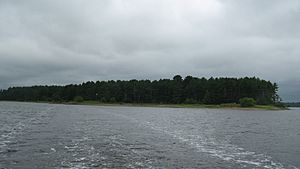Beaubears Island facts for kids
Beaubears Island (called Île Boishébert in French) is an island in New Brunswick, Canada. It sits where the Northwest Miramichi and Southwest Miramichi Rivers meet. This island is famous for its important history.
During the French and Indian War (a big conflict in North America), it was a safe place for Acadian refugees. These were French-speaking people forced to leave their homes. The camp was led by Charles Deschamps de Boishébert et de Raffetot, who helped Acadians resist being moved.
Today, Beaubears Island is home to two special places:
- The Beaubears Island Shipbuilding National Historic Site
- The Boishébert National Historic Site
The shipbuilding site is on the east side of the island. The Boishébert site covers the rest of the island and a nearby area called Wilson's Point. Wilson's Point is a provincial historic site. Both sites are managed by Parks Canada and a group called the Friends of Beaubears Island. The island still has very old Eastern White Pine trees. This makes it important for both human history and natural history.
Island History
Long before the Acadians arrived, the Mi'kmaq people used to camp on Beaubears Island. It was a significant spot for them.
Boishébert and the Acadians
During the French and Indian War, Charles Deschamps de Boishébert et de Raffetot led the Acadians and Mi'kmaq. He helped them resist the expulsion by the British. To keep Acadians safe, Boishébert created a refugee camp on the island. This camp was known as Camp de l'Espérance, meaning "Camp of Hope." It was active from 1756 to 1759.
After the fortress of Louisbourg fell in 1758, Boishébert moved many Acadians. He brought them from places like Port-Toulouse (now St. Peter's, Nova Scotia) to Beaubears Island. This was a safer place on the Miramichi River.
More Acadian refugees came to the island during other campaigns. These included the Ile Saint-Jean Campaign and the St. John River Campaign. The camp eventually held about 900 French refugees. Sadly, over 200 of them died at the camp. During the war, 16 French cannons at French Fort Cove protected the camp.
In September 1758, a British officer named James Murray visited Miramichi. He found many starving Acadian refugees up the river. They had fled from the Ile Saint-Jean Campaign. Most of them hoped to go to Canada.
Beaubears Island and nearby Wilson's Point are together known as the Boishébert National Historic Site of Canada.
Shipbuilding on the Island
The first shipyard on Beaubears Island was started in 1790. It was built by James Fraser and James Thom. For a long time, Fraser's shipyard was very important in New Brunswick.
The 1850s were a "golden age" for shipbuilding in Miramichi. Many shipyards, including those on Beaubears Island, were busy. The last ship built on Beaubears Island was likely the La Plata in 1866.
By the end of the 1800s, the island seemed empty. The O'Brien family bought it in 1920. Later, in 1973, Joseph Leonard O'Brien gave the island to the Canadian government. He was a former lieutenant governor of New Brunswick.
The Beaubears Island Shipbuilding National Historic Site is also called the J. Leonard O'Brien Memorial. It's a special place because it's an undisturbed archaeological site. This means it holds important clues about the 19th-century wooden shipbuilding industry in New Brunswick. The island is a key part of Canadian history.
Affiliations
The museum connected to Beaubears Island works with several groups:




